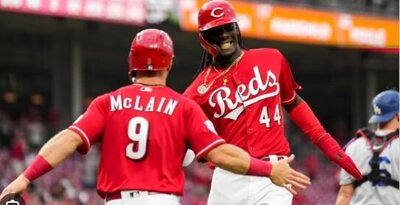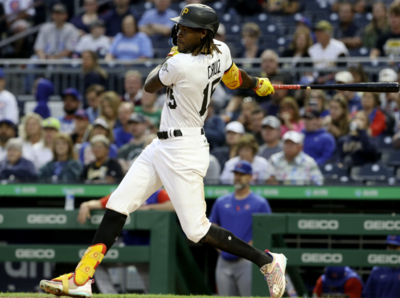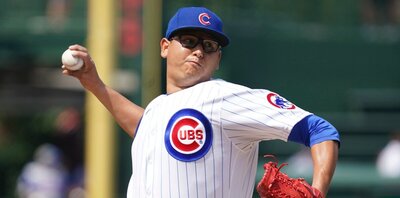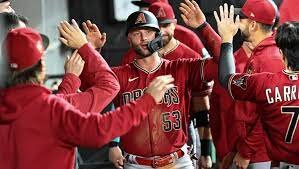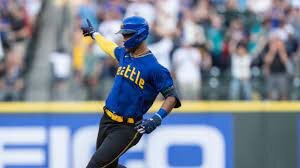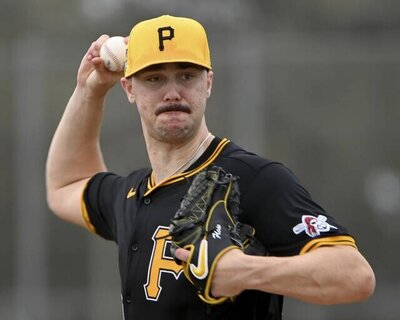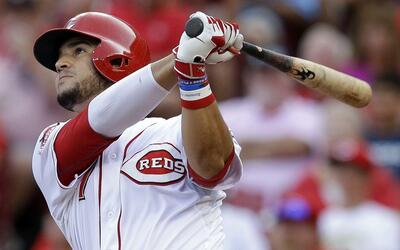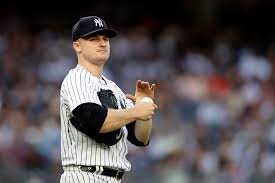Colorado Rockies:
RF Playing Time: Michael Cuddyer vs. Tyler Colvin
Prior to the 2012 season, the Rockies signed former Twin Michael Cuddyer to a 3-year, $31.5 million deal that appeared to lock their middle of the order in place for the 2012-2014 seasons. Cuddyer's history of playing multiple positions was appealing for a Rockies team that had holes around the diamond, but in Cuddyer's first season he primarily stuck to the OF as just 205 2/3 innings of the 700 innings he played (25%) came at a position other than RF. All of those innings came at 1B. Cuddyer was only able to get 101 games in before succumbing to a recurring oblique injury that ended his season. The injury was one of many for the Rockies key players and allowed younger players like Tyler Colvin to emerge. Colvin showed little growth from his days with the Cubs where low BB Rates and high K Rates often overshadowed some impressive power potential. In Colorado though the gap power played up as Colvin slugged .531 and put together an appealing 5x5 line of .290-62-18-72-7 in 136 games.
Colvin was especially deadly against RHP, where he hit .297/.334/.556 and as a result he's earned the opportunity to potentially platoon with Cuddyer who owns a career .288/.377/.499 career line vs. LHP. Colvin (.270/.302/.450) vs. LHP certainly won't threaten Cuddyer there, but Cuddyer's career .263/.324/.436 (.760 OPS) vs. RHP does open up the door for competition. This would be a concern for Cuddyer owners as Colvin would be on the stronger side of the playing time platoon. This is where Cuddyer's positional flexibility should come in handy for fantasy owners. With Todd Helton entering his 17th season in Colorado and struggling to stay healthy the last few years (118 games, 124 games, 69 games last 3 years), Cuddyer's playing time should be supported by the ability to work into the lineup at 1B as well as the enhanced interleague play schedule.
Cuddyer's draft stock appears to be impacted by the playing time threat. He's currently going outside of the top 150 picks according to the most recent NFBC average draft position data, which is way too late for a player that we currently have in the Top 100 of our VAM rating for traditional 5x5 leagues. As camp continues we'll pay close attention to the quotes out of camp surrounding Tyler Colvin, Michael Cuddyer, and Todd Helton, but the Rockies meaningful investment in Cuddyer coupled with his positional flexibility would suggest that his playing time is safe. As a result, Cuddyer looks like a tremendous draft-day value in our eyes.
Competition for Rafael Betancourt?
The Rockies biggest offseason acquisition was Wilton Lopez, a RP for the Astros who recorded 10 saves after finishing the season as the closer. Lopez is a 29 year old reliever who has posted exceptional supporting skills throughout his career. Lopez has always been able to keep the ball on the ground (career 55.9% GB Rate) while limiting his BB's (4.3% BB%) and striking out a league average 18.4% of batters faced. Lopez's strong secondary skills have translated to a tidy 3.14 ERA and 3.17 xFIP in his career. His strong audition in the Astros closer role last season coupled with a skill-set suited for the rarified air in Colorado provides some suspicion about the Rockies intentions with Rafael Betancourt. Betancourt has been successful in the closer's role in Colorado but he does have some secondary skills that cause problems in the thin air. Betancourt's career 49.9% FB Rate can cause problems in Colorado (1.30 HR/9 in 2010, 1.01 HR/9 in 2011), but Betancourt did show some improvement last year increasing his GB Rate to 36% while inducing more contact early in the count. The Rockies have suggested they'd like to use Wilton Lopez to spell the 38-year-old Betancourt occasionally but have not talked about opening the position to a competition. While Lopez provides a threat to the closer's role Betancourt hasn't had in recent years, it's important to note primary setup man Matt Belisle has posted similar peripherals the last few years to Wilton Lopez and earned few opportunities to surpass Betancourt.
Florida Marlins:
Logan Morrison breakout finally here?
Logan Morrison's first 1100 plate appearances at the big league level have shown strong secondary skills, but left a lot to be desired for fantasy owners. Morrison has posted an 11% BB Rate and .192 ISO along with a tidy 6.5% swinging strike rate. All 3 metrics are well above average, but Morrison has posted an underwhelming .250/.339/.442 line. Morrison's .281 BABIP which has been hampered by unusually high infield fly-ball rates (12.6%) is a big part of the reason Morrison's batting average has been a detractor for fantasy owners. In addition a career 45.7% GB Rate has limited some of the power breakout potential we saw in 2011 (23 HR's, .221 ISO). In addition, health hasn't particularly been on Morrison's side. Morrison's 2012 was hampered by a lingering knee injury that required offseason surgery. Morrison still hasn't been cleared to run and there are concerns about his availability for opening day. Could we see a repeat of 2012? Clearly, Morrison will need to have the knee healthy in order to get his promising young career back on track. If he's able to get healthy he has 25 HR, 90 RBI potential in the middle of the Marlins order. This is a story we'll continue to follow through spring training, but Morrison's current average draft position (285) suggests there's almost no risk in drafting and stashing with the hopes the health returns. The last time we saw a healthy Morrison he was hitting .247/.330/.468 as a 23-24 year old. Morrison turns 26 this August and with strong plate discipline and contact skills, a potential slugging 1B hitting his prime years is an attractive buy-low target.
Justin Ruggiano - late bloomer or flash-in-the-pan?
Outside of a couple cups of coffee with the Rays, Ruggiano finally got an extended look last year with the Marlins. He responded by hitting .313/.374/.535 in 320 PA's, posting a wRC+ that ranked 14th in all of baseball for players with at least 300 plate appearances. The .900+ OPS was better than Ruggiano's impressive career rates at the minor league level (.844 OPS in AAA, .896 OPS in AA) and certainly suggest some regression on the way. A look at his indicators (9.1% BB%, 26.3% K%, 20.6% LD Rate, 16.7% HR/FB Rate) suggest Ruggiano was a big swinger who hit the ball with authority whenever he did connect. His 414 ft average distance on HR's confirms as does Ruggiano's 309 foot average on fly balls in total.
Ruggiano did fade as the season went on as evidenced by his OPS by month (June - 1.215 OPS, July - .999 OPS, August - .833 OPS, September - .676 OPS), but still maintained above average production in three of the four months he earned playing time. Given Ruggiano entered 2012 with a career .621 OPS on 207 PA's, the 2nd half fade is a concern. Players that come out of nowhere at age 29 and have multiple seasons of productivity are few and far between, but Ruggiano will certainly have every chance to prove his worth again on a rebuilding Marlins team. While we know Ruggiano's .401 BABIP and consequently .300+ batting average will come down, his power-speed combination (13 HR, 14 SB in 91 games, 4 seasons of 15+ HR, 20+ SB in the minors) warrants taking a shot on a current ADP outside the Top 270. Ruggiano has a higher likelihood of flaming out with more prolonged exposure at the big league level than he does of replicating his 2012 pace, but with almost no downside to his current price tag, he remains a late round sleeper we recommend taking the chance on. If Ruggiano is the exception to the late bloomer rule, his upside (as displayed last year) is that of a Top 30 OF, for his current draft price it's an acceptable risk to take.
Chicago Cubs:
The Last Rotation Spots
The Cubs overhauled their rotation in the offseason by bringing in Edwin Jackson, Scott Baker, Scott Feldman, and Carlos Villanueva via free agency. Jackson is locked into a rotation spot alongside Matt Garza and Jeff Samardzija but the other three free agent acquisitions are in line to compete alongside Travis Wood for the final two rotation spots. On Thursday, the Cubs indicated they don't expect Scott Baker (Tommy John Surgery) to be ready for opening day, narrowing the competition (at least to start the season) down to a three-man race for two slots. All three pitchers have bullpen experience but Villanueva is the one who has been the most successful in a prominent bullpen role (3.84 xFIP as a reliever) and as a result Wood and Feldman have the early lead on a rotation slot heading into camp. We'll continue to monitor the battle throughout camp, but each pitcher has flashed appealing skills at different points in their career. Villanueva has flashed the most strikeout potential as a starter, while Feldman has shown the best combination of durability and ground balls, and Travis Wood has had the most success (4.22 ERA, 1.25 WHIP). My personal preference from a fantasy potential would be: 1) Scott Baker (when healthy, back-end mixed league potential), 2) Travis Wood (spot-start, mixed league potential), 3) Carlos Villanueva (spot-start, mixed league potential); and then 4) Scott Feldman (spot-start, deep league potential), but each of these guys likely only merit deep-league and NL Only league value during the draft season with Feldman and Wood seeming the two most likely candidates to being the season in the rotation.
Marmol or Fujikawa the closer?
It hasn't been a great offseason for Carlos Marmol's fantasy value. Marmol has been in decline for the last 3 years as declining swinging strike rates have forced Marmol to work deeper into counts and allowed his BB Rates to steadily raise. Last year he walked 18% of the batters he faced and posted a 1.54 WHIP, but an otherwise inept Cubs bullpen around him allowed him to keep the closer's role. Pitch F/X data shows Marmol recovered his loss in average fastball velocity but in doing so also threw far fewer sliders than he ever has in his career. Marmol's wipeout slider is his dominant swing and miss pitch and has hitters have adjusted to making him locate a fastball and work from behind in the count, Marmol's BB Rates and HR/9 Rates have expanded dramatically. His 4.39 xFIP last year suggests a pitcher that is borderline roster-worthy in the pen, let alone a closer.
This offseason the Cubs addressed the issue by signing Japanese standout reliever Kyuji Fujikawa. Fujikawa has posted FIPs below 2.00 in 6 of the last 7 years in Japan while posting strikeout rates routinely above 12 batters per nine innings. While the addition provides a legitimate next-in-line option for the Cubs, Marmol didn't do himself many favors by getting involved in off-the-field domestic abuse case this offseason in his native Dominican Republic. At this point, nothing that will impact Marmol's playing time on the field is expected to take place as a result of the altercation, but the negative headline is just another strike against Marmol's future with the club.
In the last year of a three-year deal Marmol does have some early season security in the closer's role, if only because the Cubs would like to maximize his value via trade. This is where drafting Marmol as a long-term hold becomes a shaky proposition. If Marmol succeeds early in the season and regains the top form that procured saves in a more WHIP-friendly manner, the Cubs will likely pursue cashing in on his value at a position that almost all contending teams seek help around the deadline. If Marmol were to be dealt, there's some likelihood he could retain value as a closer, but more likely he'd be acquired in a setup role as we've seen with other non-contending closers in deadline deals of the past. If Marmol falters early in the season and shows little hope of resurrecting his value, it's likely the Cubs turn to the newly acquired Fujikawa whom they have a commitment to beyond the 2013 season. As a result, while Marmol will sit atop the depth chart in the closer's role early in the season, I see little chance he's closing for anyone by the 2nd half of the season. At the closer's position we often draft role ahead of skill, but in Marmol's case with the role unlikely solidified for the season, I think plenty of non-closing candidates should be considered ahead of him. He's a player I'm unlikely to draft this season, while Fujikawa is something I think is extremely likely to be closing by July.
Michael Pineda (SP - NYY): The twitter-sphere was abuzz on Thursday as reports of Michael Pineda having lost 20 lbs and "potentially" being on-pace to make a June return gave fantasy owners renewed interest. I read the article on Pineda as I do any of the dozens of spring training stories you'll hear over the next few weeks about players being in the best shape of their lives and wasn't particularly inspired by quotes from Pineda that he "hopes" to return by June and from Cashman that he "could" contribute by June. For me, those sound like the optimistic side of the timeline for Pineda, not to mention we have little understanding of how the shoulder injury impacts Pineda's effectiveness. Shoulders are always more scary than elbows because we have less effective treatment histories and recovery patterns. While we can chalk the news up to "positive" for Pineda I'm not sure it should impact the way you treat him on draft day. In leagues with DL slots, he's a solid stash candidate. Similarly in deep leagues (AL Only, 15 team mixed) Pineda has some value stashing, but those in traditional mixed leagues without DL spots should avoid.
Sergio Romo (RP - SF): The player I've received the most offseason keeper questions about? Sergio Romo. Romo is an elite reliever (career 2.41 FIP) who finally found himself in the closer's role last season and saw a huge jump in his fantasy value. The Giants have always known Romo is an elite relieving option but they've tried to protect a balky elbow that has landed Romo on the DL a number of times in his career. As a result Romo has only topped 40 innings in 3 of his 5 major league seasons and 50 innings just twice. While Romo enters camp as the undisputed closer, manager Bruce Bochy has already hinted the Giants will be cautious with Romo's workload. While I have zero doubts Romo will be effective, I do wonder if his fantasy value is inflated a bit early on by expectations of a 60+ inning workload that most closers get. Early ADP data would say no, as Romo is being drafted outside the Top 10 RPs, but the number of keeper questions I've gotten on Romo have me curious. I'd comfortably draft Romo as a Top 10 RP, but I'm holding my innings expectation down around 50 with a saves expectation in the high 30's.
Wilson Ramos (C - WAS): Wilson Ramos reportedly caught his first bullpen session of the spring on Thursday and indicated afterwards that his surgically repaired knee is at 90%. After a strong first full season in 2011, I thought Ramos was prepared to take another step forward in 2012. Instead his season was cut very short as he managed just under 100 PA's before suffering a season-ending knee injury. The Nationals have indicated they plan to take it slow with Ramos and start him off as the backup catcher to Kurt Suzuki, but I'm still bullish on Ramos' talent and believe he's being under-looked as a fantasy asset in Washington. Ramos has played just 160 games at the major league level and so far he's posted a 5-category Roto line of .269-64-19-67-0, which would've been good for a back-end top 10 finish if placed amongst catchers last season. A 160-game expectation is certainly unfair to place on Ramos as a catcher in the NL, but the sample helps illustrate some of the upside. Ramos' 2011 breakout season showed above average power (.177 ISO) with a strong 8.7% BB Rate and league average chase rates (33%) and contact rates (79.8%). The skills remain there for another strong fantasy season, especially in a deeper lineup than Ramos was a part of in 2011. He's a catcher with Top 15 potential, currently being drafted outside the Top 20 at the position and someone that owners in deep leagues should be willing to gamble on. As he gets healthy he'll easily surpass Kurt Suzuki as the starter thanks to a better bat and similar receiving skills.
Brett Anderson (SP - OAK): Brett Anderson has long been one of my favorite young pitchers in all of baseball. In starting pitching, we look for three primary components: 1) pitchers who can get strikeouts; 2) pitchers who can limit home-runs, usually through strong GB rates; and 3) pitchers who can limit their walks. In Brett Anderson's career he's posted a 54% GB Rate (allowing just 0.78 HR/9), struck out 18.3% of the batters he's faced, while walking a puny 5.8%. While the strikeouts rates are just league average, the ground ball and control rates are elite. Throw in a strong pitching environment in Oakland and it's easy to see why Anderson has posted a 3.57 ERA and 1.25 WHIP in his career. Unfortunately for Anderson fantasy owners and enthusiasts like myself, he's failed to top 115 innings in each of the last three seasons. Anderson's had oblique issues last season after his recovery from Tommy John Surgery in 2011. A year removed from Tommy John, I hoping Anderson can continue to build on the strong small sample we got last year. While he'll be hard-pressed to replicate the 1.03 WHIP or the 2.57 ERA, his 3.06 xFIP heavily influenced by a career high 59% GB Rate suggests a low 3's ERA and 1.20's WHIP could be in his future. Anderson is still being drafted a bit on potential as his ADP is hovering just outside the Top 150 overall. Even an Anderson apologist like myself would admit that's on the high end of where I'd like to take him, but I'm optimistic about Anderson even if he's being treated like a growth stock in the preseason.
Derek Holland (SP - TEX): Derek Holland was in the news on Thursday as stories out of camp suggest the Rangers have asked Holland to politely stay out of the news a bit more this season and take his craft a bit more seriously. Holland's personality was allowed to shine through when he was posting a 16-5 2011 season, but is being asked to tone it down after a "down" 2012 season (4.67 ERA, 12-7 record). Holland's career-path has been a bit maddening. In different spurts he's flashed all three elite skills you'd like to see. In 2010, he struck out 21.3% of the batters he faced. In 2011, he posted a commendable 46% GB Rate; and in 2012 he cut his BB Rate down to 7.1% of batters faced. Unfortunately the combination of the three skills has never surfaced for more than a few starts and Holland's fantasy owners have been left trying to solve the enigma on a start-to-start basis. Last year Holland actually cut his WHIP by 10% (1.22 WHIP, 1.35 the previous year) thanks in part to a reduced BB Rate and some good fortune, but still saw his ERA rise by nearly 20% (4.67 ERA, 3.95 ERA in '11). The HR ball was the big problem last year as Holland's FB Rate reverted to 40+% and over 15% of them cleared the fences. It's easy to dream on the 26-year-old Holland putting all the components together in one season, but past history suggests it's unlikely to come. The strong offensive environment in Arlington will probably keep his ERA in the low-to-mid 4's and without a dominating K Rate, his fantasy value becomes heavily reliant on W's. His current 22nd rd ADP doesn't suggest fantasy owners are expecting much, but it's hard to even see value in that ADP currently. A long-time fantasy kryptonite of mine, I'm even starting to lose faith that Holland will figure it all out.
Brett Lawrie (3B - TOR): one of the biggest disappointments of the 2012 fantasy baseball season, owners appear to be taking a slightly more cautious approach to Lawrie early on. Most are still betting on a version closer to the 2011 Lawrie than the 2012 as he's still going inside the Top 70 overall, but his ADP has regressed from the Top 40-50 he saw last season. Lawrie's a difficult player to project because the two samples we've seen are so vastly different. In 2011 Lawrie was a fly-ball, power-hitting machine who was efficient on the base-paths and a terror for opposing defenses. In 2012 Lawrie posted a 50.2% GB Rate, chased 31% of pitches outside the zone (22% in 2011), and was caught stealing 8 times in 21 attempts along with numerous other gaffes on the base-paths. Perhaps most concerning was how consistently below average he was all season. Lawrie posted just ONE month with an .OPS above .725, and finished on a down note posting a .670 OPS in the 2nd half. Just 23, Lawrie should have more growth in the power department but it's important to note, he posted just one minor league season with a slugging % above .455. It's easy to say Lawrie's 2013 prospects fall somewhere in between his 2011 and 2012 seasons but it's hard to feel confident about any projection placed on him. I'm inclined to believe a rebound in the power department is coming and the R/RBI production will get boosted by an improved lineup around him, but the range of outcomes around Lawrie's 2013 season remain high. Our current projection considers him fairly valued based on ADP.
Mark Teixeira (1B - NYY): After a 3rd consecutive year of Teixeira's performance leveling off, fantasy owners have started to treat Tex like a forgotten asset. His ADP has dipped outside the Top 60 as the declining 5-category Roto production is being more focused on than the skills. Teixeira's skills aren't free-falling like his 5-category production might suggest. A down year in counting totals due to a reduced # of games played has weighed heavily on owners' minds. Digging in on Teixeira's skills though you see more leveling than precipitous decline. His BB Rates and K Rates have modestly declined alongside one another as he's putting the ball in play earlier in counts than he has in the past, while his ISO has stayed between the new normal (for him) of .220-.240. The 1st gap down for Tex actually came back in 2010 but an elite Yankees lineup around him inflated R/RBI totals and fantasy owners largely missed it. As the Yankees lineup around him has thinned, Tex's R/RBI totals have started to normalize and he now appears to be a .250-85-30-95 type hitter. The batting average won't rebound as Teixeira's stopped using the whole field, but the power should rebound after an abnormally high GB Rate last year (41%, career 38.3%). Look for that to settle back in around 35-38% where it's typically been with the Yankees which will allow Tex to challenge 30-35 HR's once again along with 95-100 RBI's.
Ricky Romero (SP - TOR): Ricky Romero was quoted on Thursday as saying his elbow feels "100 times better" than last year. Romero's performance last year fell off more than any other starter in baseball. He continued to get GB's (53.5%) at a strong clip, but his swinging strike rate dropped from 9.6% to 8.3% and his K% (15%) and BB% (12.7%) were both way worse than the league average. Romero didn't undergo any surgery on the elbow, so questions remain over how healthy he'll be heading into this year. Given how bad he was last year, I'm inclined to take a wait-and-see approach with Romero. We're currently projecting a rebound, but I personally need to see much-improved command from Romero in the spring before I invest a draft pick in him. Indicators suggest there's plenty of room for a rebound, but with no offseason procedures done on the balky elbow, I'm a bit skeptical rest will simply bring back the 2011 version of Ricky Romero.
Reid Brignac (MI - COL): The Rockies acquired Reid Brignac on Thursday from the Rays. The Rays needed to clear space on their 40-man roster and the Rockies wanted to pursue some more infield depth behind Troy Tulowitzki and Josh Rutledge. The transaction provides little value on the Colorado side other than giving them some insurance in the MI, but would seem to lock in Ben Zobrist as the backup SS option should something happen to Yunel Escobar, potentially allowing Zobrist to retain the SS eligibility he earned in 2012.
Follow us on Twitter all year: @Fantistics and @drewdinkmeyer

